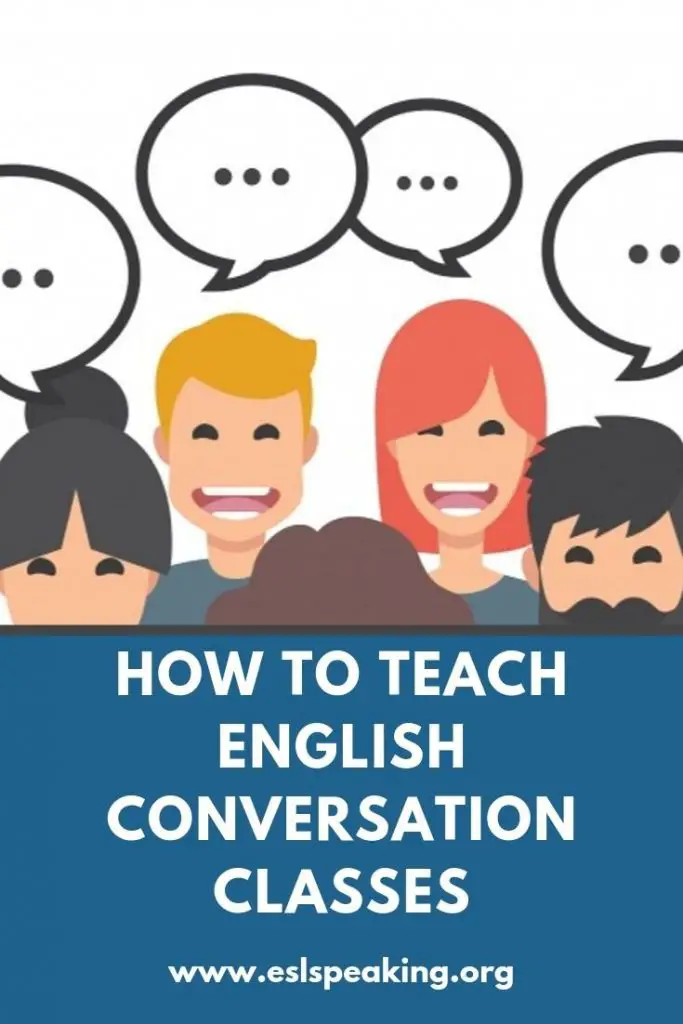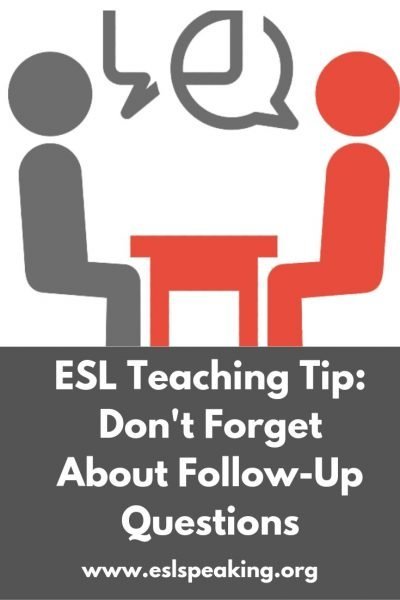Many foreign ESL teachers abroad, especially in places like South Korea, teach predominantly English conversation classes. Some teachers (and students too!) have the perception that teaching English conversation involves just “talking” to the students. Keep on reading to find out how to teach conversational English and have an awesome English conversation class.

How to Teach English Conversation
Free-talking does have a role in helping students learn English. However, it shouldn’t be the only thing we do in our English conversation classes. Find out all the details you need to know about how to teach English conversation.
Teaching English Conversation: More than just Free-Talking
There is far more to English conversation than just free-talking. In my first year of teaching, I was given a “free-talking” class with middle school students. My boss told me to just talk to them. The students wanted to just hang out and speak in English.
After a couple of weeks of this, I felt like nobody was actually learning anything! The students were just making the same mistakes, over and over again. I introduced a bit of structure, introduced some new grammar and vocabulary and found that the class went much more smoothly.
The best part? The students improved their English skills! Teaching conversational English can be done in a much better way. Check out these tips and tricks for English conversation classes.
- Amazon Kindle Edition
- Bolen, Jackie (Author)
- English (Publication Language)
- 211 Pages - 07/12/2020 (Publication Date)
English Conversation Activity Ideas
Try out these games and activities that are guaranteed to get your students talking. The best part about them is that you can target some specific grammar or vocabulary, and push students to integrate these things into their previous knowledge base.
This is better than free talking because I find that students often just use the same few grammatical structures and 100-200 vocabulary words they always use.
Partner Conversation Starters/Role-Plays: An excellent way to get even low-level students started with English conversation. These students can speak in English to each other if you give them the structure to be able to do it.
Small Talk ESL Activity: Small talk is a vital, yet often neglected aspect of English conversation. Give your students some serious practice in it with this activity. It’s fun, challenging and has an element of competition to it.
Advanced English Conversation Dialogues: Check out this book on Amazon if you want to help your students learn idioms and phrases in American English through dialogues.
Surveys: I love a good ESL survey because they cover all 4-skills, are completely student-centred and can cover just about any grammar or vocabulary point. I use them so often in my own classes that my students let out a bit of a sigh, but I know they secretly love them. Haha! Here are six ESL surveys that I use in my own classes with university students in South Korea.
ESL Pronunciation Activities: Students from most countries struggle with certain aspects of English pronunciation. Here are some of my favourites games and activities to work on this specific speaking skill. It’s conversational English classes made easy.
Test Teach Test: Consider mixing things up a little bit and trying something new. This style of teaching directly targets students’ needs but does require some planning on the fly. Try it out for a nice change of page.
You may also want to have a look at these last day of school game and activity ideas.
English Conversation Starters
If you’re looking for some ideas to get some interesting discussions going, check out the following below. They can turn into an entire class, or you can use them for a quick warm-up at the beginning of class.
Top 10 Conversation Starters for Adults
Top 10 Discussion Starters for Children
Principles for Teaching English Conversation: Top 17
Here are a few quick things to keep in mind as you teach English conversation.
#1 How to Teach English Speaking: Repetition is Key
Be sure to provide plenty of opportunities for your student to practice. Start out with controlled practice, and then move to freer speaking sessions where students can experiment with using the language. Then, follow-up with review in subsequent classes.
Another thing to think about is teaching language in “chunks.” If students can get to the point where these things become automatic, they’ll be well on their way to becoming fluent in English.
See Scott Thornbury: How to Teach Speaking, Chapter 2 for more details on “chunks” or multi-word units. Here are some examples that he mentions:
Collocations (rich and famous)
Idioms (cool as a cucumber)
ESL Phrasal verbs (log out)
Sentence frames (would you like a…)
Discourse markers (by the way)
#2: Context is Necessary
Good lesson plans always begin with activating prior knowledge and finish with personalization. This helps to make the language far more memorable. We can study all the vocabulary and grammar we want, but if we don’t know when to use it, it’s useless to us.
For example, it’s not that useful to teach vocabulary when it’s not with other related words. For example, here’s a lesson for asking permission. Keeping this in mind makes conversational English classes much more valuable and memorable.
#3: Student-Centred is Always Best
“It is a lack of genuine speaking opportunities which accounts for many students’ feeling that however much grammar and vocabulary they know, they are insufficiently prepared for speaking in the world beyond the classroom.”
Help your students feel prepared for the real world by giving them plenty of opportunities to practice using English in your class. The best way to do this is student-centred teaching.
For more on this, check out: ESL teaching philosophies.

English teaching: conversational skills
#4: Listening + Reading = Also Important
An integrated approach to language teaching reflects the real world because in most cases, students will have to use a combination of skills. Studies have shown that extensive reading aids in written and spoken skills and not just in reading.
In my experience, students who watch a lot of English TV or movies are often the best at knowing when to use a certain phrase or idiom as well as just having a natural “feel” for the language which is almost impossible to teach.
In order to assist students, we can use integrated approaches such as the task-based approach or the communicative approach. Learn more about it here: language learning methods.
- Amazon Kindle Edition
- Bolen, Jackie (Author)
- English (Publication Language)
- 114 Pages - 05/30/2015 (Publication Date)
#5: Fluency + Accuracy = Keep in Balance
In years gone by, it was all about accuracy when speaking and in places like Korea, it’s still predominant with the use of things like the audio-lingual and grammar-translation approaches in public education.
Many teachers revert to this as well simply because it’s easier to pick out errors in pronunciation, vocabulary or grammar and then correct them than it is to help students speak more quickly or easily.
However, there has been a radical shift in thinking in the past 10 or 20 years and there is a focus on fluency before grammatical accuracy. It’s how we learn our first language when we’re young. We utter things, fluently, that actually make no grammatical sense but grammatical accuracy comes later.
Similar to the previous point, you can use communicative, task-based approaches that are kind of like throwing students into the deep-end and just expecting them to swim as opposed to guiding them along by the hand, to deeper and deeper water.
- Amazon Kindle Edition
- Bolen, Jackie (Author)
- English (Publication Language)
- 211 Pages - 12/21/2022 (Publication Date)
English Speaking Activities to Build Fluency
You could also try some of these activities to work on building fluency:
- Amazon Kindle Edition
- Bolen, Jackie (Author)
- English (Publication Language)
- 159 Pages - 09/11/2023 (Publication Date)
#6 Teaching English Conversation Classes: Don’t Forget to Have Students Change Partners
In the ESL/EFL world, fossilization is what happens when an error that a language learner makes becomes permanent, and cannot be fixed, no matter what further forms of input or error correction that the learner is exposed to.
Maybe you’ve had this experience before when you were learning a language? Despite being aware of an error, you just felt powerless to be able to fix it when speaking. If that’s the case, we recommend visiting a site like LegitimateEssayWriting, that reviews the best academic writing services and may be helpful to you as well.
I use this term to apply to ESL Speaking classes and what happens when students sit with the same person every single day and talk to only that one person. They basically become fossils, unable to move, or break away to find a new partner. There are a number of reasons why you’ll want to prevent this from happening in your English classes.
Sticking with the Same Partner Every Single Class is Bad! Here’s Why
Fossilization of language learning partners is bad for a lot of reasons including:
- That poor person who gets stuck with the worst student in the class. The burden should be spread among everyone.
- It gets boring to talk to the same person every day.
- It doesn’t train students for life. I want my students to be able to converse with almost anyone, in English.
- Mistakes get fossilized among partners. Maybe someone makes a mistake that impedes meaning. Their partner asks for clarification once and the person gives it and then continues to make that same mistake over and over and never gets any more feedback that that mistake is impeding meaning.
- There’s no chance for many students to encounter a partner at a slightly higher level of language development (the zone of proximal development), which can be extremely helpful.
- Other. Can you think of more reasons? Leave a comment below and let us know.
How to Mix Partners Up When Teaching English
It’s really easy to mix it up and make the students change partners. I usually do it randomly by just assigning numbers or letters or whatever, but there are plenty more scientific ways to do it too, including phone apps or websites.
For example, if I want to make groups of threes, I’ll count the number of students in the class (24). Then, I’ll number the students from 1-8. There are should be 3 “1’s,” 3 “2’s” etc. All the 1’s go together, all the 2’s etc.
Here’s one website you can use to do this: Random Team Generator. Just keep all your class lists in an easy to access place so that you can cut and paste them into this at the start of each class.
You might want to do this before students arrive (and have it showing on the PPT) so they can just sit with their partner from the beginning. This can save a few minutes of class time that is usually lost to what I call the “shuffle.” This is a great tip for ESL English conversation classes.
Mixing Partners Up For Twice a Week Classes
I often teach the same class twice a week, so I’ll generally let students sit with their friends for one class and then assign a random partner for the next one. For example, Mondays are with a friend and Wednesdays are with a random person.
This seems to satisfy most students. They do get to hang out with their friends for half the time but get to freshen things up with a new partner for the other half.
#7 How to Teach Someone English: Provide a Demonstration
A normal way that people learn a language is by first “seeing” and then “doing.”
You can demonstrate the target language to your students in various ways such as using a video clip from a movie, song, podcast, or the MP3 listening files and reading exercises that are in your textbook.
Of course, you, the teacher, can also provide an example for your students but it’s good for them to hear different genders, accents, and levels of English speakers so be sure to change it up from time to time.
Keep in mind that there are many English speakers in the world who speak English as their second, third or fourth language so be sure to use some of these examples as well.
#8: Focus on Communication During Error Correction
If you try to correct every single error that your students make when speaking English or having a conversation, it can be a little bit overwhelming. Unless they’re at a very high level and make few mistakes, it’s better instead to focus on communication. Keeping this in mind, correct the following things:
- When a student is unable to get their thoughts or ideas across in a way that you or other students understand. Basically, anything that’s a significant hindrance to meaning.
- If you hear the same thing over and over again (mistake with the simple past negative form 2-3x in a minute or two for example).
- Vocabulary or grammatical points that you’ve taught in that specific class.
- Very simple mistakes that students at their level should have down cold in their sleep!
- Amazon Kindle Edition
- Bolen, Jackie (Author)
- English (Publication Language)
- 68 Pages - 11/12/2019 (Publication Date)
#9 Conversation Class in English: Allow for some Freedom with Conversation Topics
You’ve probably had this experience in your first language…people are talking about something that you either have nothing to say about or that you dislike. For example, nothing makes me want to exit a conversation faster than when people start talking about the local hockey team where I live, the Vancouver Canucks. I don’t even know a single player of the team, nor do I want to!
With this in mind, allow for some freedom during conversation time in your classes. Perhaps the topic is “sports.” Instead of specifying that students talk about a certain local sports team, make it more general and use a question like this, “Would you rather play sports or watch them?” Most people would be able to answer this question and talk about it with a partner for at least a minute or two without too much pain!
#10: Small Group and Pair Work is Best
If your students are serious about improving their English speaking and conversation, they’ll need to practice a lot! The best way that this can happen is if you break up the class into smaller chunks. Instead of having a big conversation with you + 10 students, put them into pairs of groups of 3-4. This will increase the student talking time in a big way.
And of course, practice makes perfect (eventually) so allow lots of time for this in your class. After all, that’s probably why the majority of your students are in your class in the first place—for a chance to speak English when they might not get to a lot in their normal life.
You’re also free to circulate the class, offering feedback, answering questions and guiding the conversation if some students are getting off track. Then, at the end of the allotted time, bring the students back together and elicit an answer or two from a student. Or, ask students the most interesting thing they learned during their conversations. Or, ask a group what they talked about.
#11 Teaching Conversational English: Don’t Forget About Vocabulary
You can usually have a simple conversation in English with very little grammatical knowledge. At least to the level where you can get your main point across.
However, if your students are weak in vocabulary, then it’s going to be a serious challenge for them to talk to each other. Even advanced level students can benefit from some vocab work if their goal is to speak and have fluent conversations. So, don’t forget to incorporate this into your English conversation classes.
Here are some of the best resources for this: ESL Vocabulary Games and Activities.
#12: Don’t Forget your CCQ’s (Check for Understanding)
When I did the CELTA course, it was ALL about CCQ’s. It stands for concept checking questions. Basically, when you teach something to the students, for example, new vocabulary or grammatical concept, don’t finish with, “Okay, got it?”
Instead, use some of these questions. For example, if you’re teaching about irregular past tense verbs: Make a sentence…dinner, last night, pizza. Your students would say, “You ate pizza for dinner last night.”
Or, “Can I say speaked.” No! Spoke!

How to teach someone English
#13: Don’t Forget to Teach Students How to Ask Questions
Many native English speakers when they go somewhere like China or South Korea teach “English Conversation.” Many people teach it poorly. Few do it well.
Be one of the ones who does it well by following this awesome teaching tip. Not to worry, it’s really quite simple and easy to make your English classes better by teaching your students all about follow-up questions.
Tip: It’s more than just talking to your students! Check out my #1 tip for doing English conversation a bit better.

Teaching English Conversation
Encourage Follow-Up Questions for a Conversation Class in English
For those who teach English conversation classes, here is my #1 tip to do it well.
Conversation is a two-way street and in order to be good at it our students need to know how to ask questions. Conversation is not simply asking and answering something like:
A: “How was your weekend?”
B: “It was good.”
A better conversation would look like this:
A: “How was your weekend?”
B: “It was good, I saw a movie.”
A: “Really? What movie?”
B: “I saw Kung Fu Panda. Have you seen it?”
Or:
A: “How was your weekend?”
B: “It was a bit boring, I just stayed home. How about you?”
A: “Oh, mine was fun, I went to my favorite restaurant.”
B. “What did you eat?”
See What I did there to Keep the Conversation Going?
An answer, then a follow-up question using one of the W/H words.
I remind my students of these key question words: who/what/when/why/where/how. I then tell them that they can almost always use at least a couple of them to ask a follow-up question to their conversation partner.
Also, teach your students question forms; it’s maybe not as obvious as you think since questions are formed in a variety of grammatical ways in other languages and your students may not know how to make them.
I’ll usually write a couple examples on the board, and leave them there for the weaker students during any English conversation activity I do. It’s kind of a crutch, but if that’s what it takes to get the weaker students speaking English, then so be it.
#14: Assess the Skill Level of your Students
When you’re teaching English, it’s vital to check on the ability level of your students. After all, if the lesson is too easy, then your students are going to get as much out of the lesson as they could. If it’s too difficult, they will likely feel quite frustrated and many just feel like giving up. Both of these situations should be avoided!
Of course, you have to prepare something for the first lesson, even though you may not be sure what level they’re at. Make your best guess and then adjust from there, either up or down once you have more information. Remember, it’s a work in progress.
My best advice for teaching multi-level classes is that there are always going to be students at the top and at the bottom. Aim for the middle 80% of the students and you’ll be doing well!
#15: Use a Variety of Teaching Materials
Nobody likes the same old thing all the time, right? Use a variety of games and activities during your English conversation and speaking classes and you’ll be well ahead of many people! This website is a great place to start, so have a look around.
You may also want to consider bringing in a variety or media: everything from videos to podcast, to newspaper articles are a great place to start a conversation class on. The more current and relevant the lives of your students, the better.
- Amazon Kindle Edition
- Bolen, Jackie (Author)
- English (Publication Language)
- 187 Pages - 03/09/2016 (Publication Date)
#16: Teacher: Talk Less. Students: Talk More
Although you should feel free to share your thoughts and ideas with your students, remember that they’re in your class to improve their speaking and conversation skills. What does this mean for you? Your students should be doing most of the talking, and you—just a little bit.
This is known as student-centred language teaching. One particularly effective way to do this is to put students into pairs or small groups and get them talking to each other, instead of with the entire class.
#17: Don’t Correct All Errors in a Conversation Class
It can be tempting in conversation classes to correct all speaking errors that you hear. But, this isn’t usually the best course of action for a few different reasons.
First of all, it can really disrupt the flow of the class if you’re stopping your students every few seconds to correct them on something. You want to encourage a free-flowing sharing of ideas and this does now allow for that.
Secondly, it can be pretty demoralizing for a student to get corrected about every single mistake that they make. If it happened to you, you’d maybe not even want to speak in a second language!
What should you do in terms of correcting errors in a conversational English class? I’ll generally focus on communication gaps. That is, if someone isn’t able to be understood or get their point across because of some mistakes with their grammar or vocabulary.
What Should I Teach English Beginners?
Like this Advice about Teaching English? Then You’ll Love this Book!
- Amazon Kindle Edition
- Bolen, Jackie (Author)
- English (Publication Language)
- 114 Pages - 05/30/2015 (Publication Date)
Yes? Then you’re going to love this book filled with practical tips and tricks for teaching English speaking: 39 No-Prep/Low-Prep ESL Speaking Activities: For Teenagers and Adults. It’s lesson planning made easy, guaranteed. If it’s not, get in touch and I’ll personally refund your money.
Spice up your English Classes with Some New Activities and Games
There are dozens of interesting and engaging English speaking activities that will help your students to have fun while learning English at the same time. Variety is the spice of life! Get some in your English classes, okay?
Available in a Variety of Formats
The book is available on Amazon in both digital and print formats. The digital one is less than a buck and can be read on any device by downloading the free Kindle reading app. How’s that for value?
Take the e-version with you to your favourite coffee shop for lesson planning on the go. Or, keep a copy on the bookshelf in your office and use it as a handy reference guide. It really is that easy to create some awesome lesson plans and have happy students!
Shop Now
You can check it out for yourself over on Amazon, but only if you want to get yourself a serious dose of ESL awesome in your life:
Is there an Audio Version of It?
We’re happy that you asked! There sure is. It’s easier than ever to get some inspiration for your English classes when exercising, doing errands or when on the go.
The better news is that can listen to the book for free by signing up for an Audible account. You get your first book free, so why not make it this one right? Head over there to check it out now:
—>39 ESL Speaking Activities on Audible<—

Teaching ESL Students to ask Follow-Up Questions
Lesson Plans for English Conversation
If you’re looking for a few lesson plans to assist you in planning your English conversation classes, check out the following below. They will work for students in just about any country. If you teach children, check them out as well. You can see the basic structure for planning your own ESL lessons.
Technology and Sleep (for adults)
Google Investing One Billion Dollars in Renewable Energy (for adults)
Learn More about How to Teach Speaking
- New
- Mint Condition
- Dispatch same day for order received before 12 noon
- Guaranteed packaging
If you’re looking for some more information about the theory behind teaching speaking to ESL or EFL students, you’ll want to check out this book about teaching speaking.
Among the options for “theory” books about teaching speaking, this one is probably the best. It’s simple and easy to understand but covers all the highlights you’d expect.
Teaching English speaking is lot more than just “talking” with the students, and Scott Thornbury does a great job at explaining this. He covers theory but also gets into the practical with lots of tips and tricks to use in your own classroom.
How Can I Engage Apathetic Students in my English Conversation Classes?

5 Tips for Engaging Apathetic Students
This information is in response to a reader question from Katrina about how to get her low level middle school students to participate in class when the last thing they want to do is speak English. I’ll start with this: It’s not easy! Engaging very apathetic students to speak in another language is a thankless job for any teacher.
However, there are a few strategies you can try. If they work, great. If they don’t, don’t worry too much about it. As the old saying goes, “You can lead a horse to water, but you can’t make it drink.” If your students truly don’t care about learning English, there often isn’t that much you can do.
This is a tough one and I’d appreciate some feedback from the readers (I’ll leave the comments open). But, here are 5 tips for engaging apathetic students that I hope will be helpful.
Tip #1: Choose Activities Carefully
The first way to engage students who don’t want to speak English is to choose your ESL activities wisely.
The best ESL activities and games are those where it’s almost easier to speak English than it is their first language. Some examples of good ones are ESL board games and surveys for ESL students. The survey one is particularly good because it gets students up and about, moving around the class.
Anything that you can do to get students out of their seats is a good thing.
Tip #2: Mix It Up in your ESL Conversation Classes
Mixing things up is perfect to keep your students on their toes. Surprise your students by introducing new activities into the classroom. Use something like this book: 101 ESL Activities: For Kids (6-13) to keep things fresh all semester long.
You can also use interesting, relevant topics. Keep an eye on current events in the country where you teach and stray from the textbook if possible every once in a while.
You can also mix up groups and partners in your class to keep things fun. For example, if I meet with a class twice a week, the students can choose their partner on Tuesday, but then I assign a random partner on Thursday.
#3: Give some Incentives to Participate for Apathetic Students
Implement a reward system of some kind with a prize that actually has some value such as a pizza party or a gift certificate to a popular store. It may cost you a bit of money, but it’ll be worth it in the end when students are actually participating.
Putting students into groups can be helpful so they can kind of police each other! For children, never have individual rewards. Group ones are far, far more effective and behaviour in your class will be much better.
Tip #4: Don’t Expect Miracles
If students are very low level and apathetic, don’t be too hard on yourself. Do your best but realize that if a student is 14 or 15 years old and absolutely refuses to participate in your class, there isn’t much you can do.
Avoid the power struggles and test of wills that you’re not going to win. If one or two students at the back of the class are sleeping, but not disturbing anyone else, don’t worry too much about it. Let them be.
Another option is to talk with them after class one day. Keep it real, and explain how it feels when they’re sleeping in your class. Or, find out if they have a valid reason for being so tired apart from video games!
#5: Praise even Small Things in your ESL/EFL Conversation Classes
If students in middle school are quite low level, they probably haven’t had much or any positive feedback about their language skills in years. Praise even small, simple things and make encouragement your #1 priority.
As my boss in Korea once told me, my goal was to make my students hate English a little less. I think I accomplished that through using these 5 things that I’ve mentioned.
Tip #6: Learn How to Teach
One of the problems with unmotivated students is not actually the students. Sometimes, inexperienced teachers struggle when they’re first starting out because they don’t really know what they’re doing. The result? Students who know that you don’t really know what you’re doing!
I have to confess, I was this person until I started to take professional development far more seriously.
If you want to get the basics under your belt, you may want to consider an Online TEFL Course.
Want to Have Better English Conversation Classes?
- Amazon Kindle Edition
- Smith, Jennifer Booker (Author)
- English (Publication Language)
- 144 Pages - 03/31/2016 (Publication Date)
Fresh, new activities is one of the keys to happy, engaged students who are speaking English. Seriously, nobody wants to do the same old thing every single class.
One way you can do this is by searching around on the Internet for something to use in your class. However, it’s often a total waste of time because you have to wade through tons of crap to find one good ESL activity or game you can actually use.
A better option is to check out this book over on Amazon: 101 ESL Activities: For Kids (6-13). It’ll make your life easier, guaranteed. There are dozens of top-quality activities for kids in a variety of levels and skills.
You can check it out for yourself over on Amazon, but only if you want some more ESL awesome in your life:
Teaching Conversational English FAQs
There are a number of common questions that people have about teaching conversational English. Here are the answers to some of the most popular ones.
What should I teach in conversational English?
There are a number of things to teach in conversational English. Here are some tips for what you should teach:
- Focus on topics that are relevant and engaging for the students (current events, hobbies, daily life, movies/tv, etc.).
- Use a variety of games and activities.
- Change partners and groups often.
- Reduce teacher talking time and get students speaking as much as possible.
- Teach vocabulary and review basic grammatical concepts if necessary.
- Teach the difference between formal and informal communication skills.
How do I start teaching English speaking?
To start teaching English speaking to beginners, consider the following things:
- Focus on communication and meaning above accuracy.
- Help students improve their vocabulary.
- Keep it simple. It’s better for students to know a few things well than many things not that well.
- Use positive reinforcement and offer lots of praise.
- Consider a variety of interactive and engaging ESL games and activities.
- Check for understanding with CCQs (concept checking questions).
What is meant by conversational English?
Conversational English is the kind of speech people use when they talk to each other casually or informally. This is different from more formal situations as in a job interview or a university lecture where more formal language is used.
How can I make my English speaking class more interesting?
To make your English speaking class more interesting, consider the following ideas. Use a variety of different topics including current events in your lessons. Be sure to change partners and groups in every class so students can talk to a variety of other people. Use different kinds of ESL speaking activities and games to keep things interesting. Finally, do everything you can to reduce teacher talking time and ensure that most of the class consists of students speaking to each other.
How to teach English conversation?
How to Teach English Conversation: Have Your Say!
What are your thoughts on how to teach English conversation? Any tips or tricks for making it even better? Leave a comment below and let us know. We’d love to hear from you. Also, check out the different ways to answer “how are you” that you could teach during a speaking lesson!
Also be sure to give this article a share on Facebook, Pinterest, or Twitter. It’ll help other busy teachers, like yourself plan their English lessons.

Teach English conversation
Last update on 2025-04-09 / Affiliate links / Images from Amazon Product Advertising API














Thanks so much for all your great tips on teaching English conversation! I’m just a beginning teacher and had no idea about lesson planning, activities, etc. and found your information so useful.
Thanks so much for your tips and ideas for teaching English conversation. I really appreciate it!
This is an interesting and informative blog post on teaching conversational English. It provides valuable insights into the importance of conversation in language learning, and offers practical tips for improving one’s ability to communicate effectively in English.